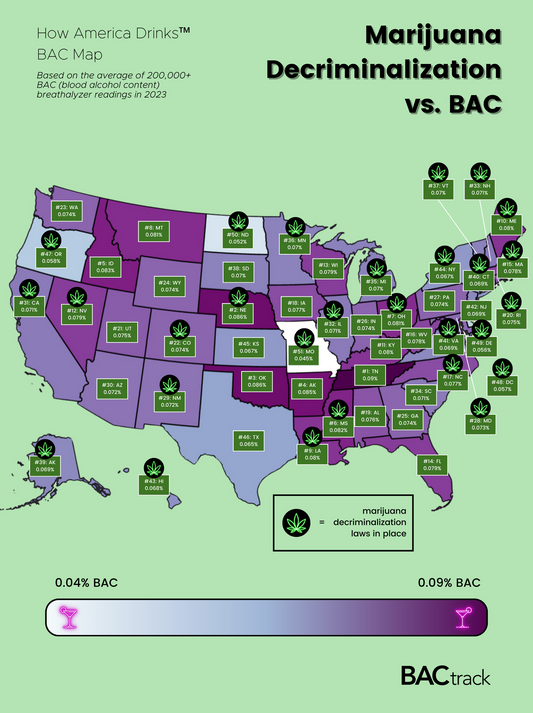BUSTED: Top 5 Breathalyzer Myths
BUSTED: Top 5 Breathalyzer Myths

There are a lot of misconceptions floating around regarding what a breathalyzer can measure, what the results mean, and who does or does not need one. In order to squash some of the misinformation, we here present the top five breathalyzer myths.
Myth #1. "You can beat a breathalyzer by hyperventilating, exercising, or holding your breath before you blow."
This is an interesting one because it's partly true. An often-cited, decades-old study found that hyperventilation and vigorous exercise did indeed lower subjects' BAC readings by as much as 10%. Conversely, holding their breath actually increased subjects’ BAC readings by up to 20%. Unfortunately, these activities can also render one light-headed and gasping for air – behavior that would undoubtedly capture the attention of law enforcement officers who are already closely examining an individual for being under the influence.
However, there's another technique used to beat a breathalyzer that is less well known--some people will try sucking instead of blowing into the breathalyzer mouthpiece, therefore drawing air across the sensor from a different direction. This technique, too, is well known to the police, and is the reason why officers often put their palms up behind the unit to ensure breath is coming out in the correct direction.
Myth #2. "I don’t need a breathalyzer – my drinking is under control (or, I don’t drink at all)."
One of the most pervasive misconceptions around breathalyzers is that they are only for people who drink to excess, and that if you can “control” your drinking, then you don’t need one.
This is totally untrue. In fact, even if you are a teetotaler, you will find a breathalyzer useful with friends or family members who do drink.
Here’s why—without a breathalyzer, there is no accurate way of measuring a person’s alcohol intoxication. In fact, the people who think they have their drinking “under control” are sometimes the most jeopardized. People may claim that they know what 0.08% BAC “feels” like, and therefore don’t need to test themselves.
There are several reasons why this is a dangerous idea. First, you don’t always know how much alcohol is in your drink. Alcohol concentrations in beer, wine, and mixed drinks can be deceptive.
Second, even as an experienced drinker, how alcohol affects you changes over time depending on a multitude of factors. As you age, the intoxicating effects of alcohol become increasingly pronounced. As you gain or lose weight, alcohol will affect your differently. If you are taking medication, if you have an empty stomach, or if your ratio of fat to muscle content shifts, you can be affected by alcohol differently from what you are used to.
Lastly, a breathalyzer is not just for you alone—it’s for the people around you, as well. Have you ever been in the party of someone who is obviously drunker than they think they are? Nothing stops a person from making bad decisions quicker than confronting their actual BAC.
Myth #3. "If my BAC is under the legal limit, I’m OK to drive."
This is one of the most dangerous perceptions surrounding the use of a breathalyzer. BACtrack units are designed to educate you on how alcohol affects your body, but you should never get behind the wheel if you are anything other than 0.00% BAC.
Intoxication begins with the very first drink. You should never drink and drive, no matter how much you've consumed. You can be impaired and arrested even if you BAC is under the legal limit. A multitude of factors influence your BAC. These factors are unique to you, and can vary from one occasion to the next. In addition, individuals with the same BAC may experience different degrees of impairment.
Use a BACtrack to learn how alcohol affects your body and your BAC. If you plan on driving, know you are at 0.00%.
Myth #4. "I can increase the lifespan of my breathalyzer by using it infrequently."
Unlike many electronic devices, breathalyzers are unique in that regular use actually improves performance. In fact, not using a breathalyzer for a month or more could actually harm the unit, in that the sensor may begin to dry out.
In order to maximize accuracy, clean the sensor by performing a test every few weeks, even if you don't intend on using it. Whether or not alcohol is present on the breath for this “sensor cleaning” doesn’t matter. The moisture in your breath keeps the sensor performing optimally.
Additionally, remember to regularly calibrate your breathalyzer according these guidelines.
Myth #5. "Breath fresheners, mints, mouthwash, garlic, curry, vitamin C tablets and old pennies can mask alcohol and/or lower BAC readings."
Grievously untrue. Breath fresheners or stinky foods may cover up the odor, but they cannot change the amount of alcohol present in your breath. Some mouthwash even contains alcohol, and therefore can inflate BAC readings.
It's unclear where the urban myth about the other substances came from. The penny myth may have originated when there was a slight amount of copper in the US penny, which may have been thought to cause a chemical reaction with a drunk person's saliva (a claim that has no basis in scientific fact). Even if this were true, today pennies are made mostly of zinc.
The Discovery Channel's Mythbusters Adam Savage and Jamie Hyneman teamed up with BACtrack officials in 2003 to test various methods alleged to beat standard breathalyzer analysis. As expected, none of these methods worked.



